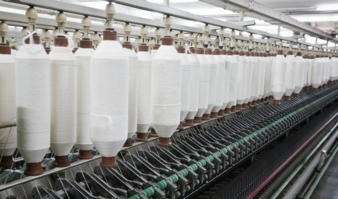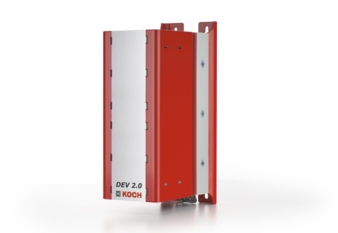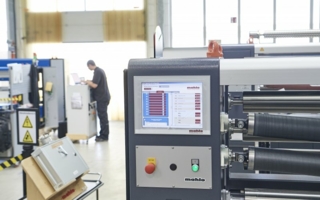03/12/2019 – Dynamic Energy Supply (DEV) protects yarns in case of power failure — auf Deutsch lesen
Michael Koch help spinning machines
The textile industry is primarily active in countries where the electrical power supply is not always reliable and guaranteed everywhere.
In the event of voltage drops or power failure, spinning mills, especially in the tension-sensitive pre-spinning stage, face the danger of uncontrolled drive shutdown leading to yarn breakage. Restoring production capability is a very laborious process. The danger is averted with a surprisingly small, active energy management system for electric drives.
It is a long way from the cotton field to the production of fine sewing thread. The processes of cleaning, shaping and finally spinning – sometimes very complicated and laborious – take place in between. Cotton must undergo several processing steps for it to be suitable for machine spinning. The spinning process itself is then additionally subdivided into two steps. First comes the cotton, which has been shaped into a so-called sliver, onto a roving machine, which is called a roving frame. Such a roving frame can be 20 meters long and have up to 300 spindles.
Pre-spinning process
The sliver is a thumb-thick fluffy rope that breaks very easily. This is brought from a meter-high drum through intermediate frames to the pre-spinning machine where the spindles draw in the pre-spun cotton. There the sliver is pulled by bands lying on top of each other and simultaneously serving the purpose of preventing the sliver from undergoing further twisting. They therefore act as a twist brake. From there the sliver is stretched and fed through a rotating fork-shaped blade, which is responsible for the twisting of the roving, and simultaneously wound onto a spool. This roving is then spun in the ring spinning machine into the yarn that has the desired features of the end product.
The tricky part in the roving frame process lies between the rubber bands that pull the sliver into the machine and the rotating blades. If the supply voltage to the drives is interrupted, the rubber bands stop immediately while the rapidly rotating blades continue to turn for a bit. As a result, the roving between the rubber bands and the roving spool breaks, and this can happen on each of the up to 300 spools. In such a case, the sliver must then be manually removed and the rubber bands, drawn out, and twisted. After this has been done, it also has to be twisted with the roving frame onto the spool. Taken as a whole, this is a very time-consuming process that also requires much fingertip sensitivity. If you also know that several roving frames run simultaneously in a yarn mill but out of cost considerations there is rarely more than one machine operator for all the machines, then a power supply interruption also means several hours of machine and production downtime. In other words, this has a profound impact on the expected and calculated productivity.
The electric drive technology
A modern roving frame is driven by several electric drives. The main drive is responsible for the spindles and the roving frame, while the others drive the intermediate frame, the rubber bands and the spindle hoist. The latter ensures that the yarn is wound evenly onto the spindles by means of the up and down motion of the frame on which the spindles are mounted. The frequency converters of all the drives are interconnected through a DC link. The most powerful converter serves as the power supply unit for everything. Its sizing therefore depends on the total power requirement of all interconnected drives of the machine.
In case of a power failure, the different sections of the machine decelerate at different speeds. While connected through the common DC link, all the drives utilize the machine’s kinetic energy which is exerted primarily in the spindle drive (that is, the strongest drive) and is thus available to all the drives. However, the kinetic energy converted to electrical energy is not enough to bring the machine with its various drives to a standstill at a continuously synchronized speed. A small quantity of energy is lacking to achieve this goal. The consequence is the ripped slivers and the great effort involved in restarting the machine.
Dynamic Energy Supply
The large machine, which is over 20 meters long and weighs several tons, only needs a relatively small additional amount of energy to come to a standstill safely and without yarn breakage in case of power failure. A simple and at the same time reliable solution is the application of the so-called Dynamic Energy Supply (German acronym: DEV) from Michael Koch GmbH from Germany. As part of the company’s product portfolio of active energy management systems for electric drives, it serves as a short-term uninterruptible power supply ensuring that the necessary amount of energy is available to the connected drive controllers or frequency converters at the predefined voltage level. And it is actually absolutely uninterruptible.
The way the DEV works is easy to explain. The Koch Dynamic Energy Supply is connected directly to the positive and negative terminal of the DC link system of the drives of the roving frame. Nothing more is required! No special programming, no startup or commissioning, nothing. Let us assume that the operating voltage level is somewhat above the rectified mains voltage, that is, about 620 volts DC. The DEV is UL-certified for up to 800 volts DC. When the machine is powered on, the capacities of the connected frequency converters are charged first. After a few seconds, and with the voltage level of the DC link stabilized, the DEV also charges its storage unit. The DEV uses an aluminum electrolytic capacitor with an energy level of about 2,000 joules as a storage medium.
Stopping without yarn breakage
Whether this amount of energy is sufficient in case of a power failure, and thus for ensuring a stop without yarn breakage, is discussed during the sizing process or application engineering which is carried out in advance with the customer for every application. There are also various tools available to perform this task independently. If more complex processes mean that a machine needs more energy than one DEV alone can deliver, the energy amount of the Dynamic Energy Supply can be increased very easily using so-called expansion modules in increments of 2,000 joules via cable and plug connections. If more power is needed, the active energy devices can likewise be connected in parallel to the DC link. This is very easily done because there is no additional effort involved. Both or several DEVs are synchronized automatically.
As soon as the DC link voltage drops from the operating voltage level, the not even shoebox-sized DEV supplies enough energy to keep it at a level that allows the drives to come to a synchronized standstill. The reaction speed of the DEV is so dynamic that even a very small and hence insignificant voltage drop of a few volts is recorded. The rest is simple. The machine receives the famous last gasp of electrical energy to avoid yarn breakage. As soon as the power supply is available again, the machine restarts without further effort. In places where the power supply is unstable, the relatively small investment in the DEV Dynamic Energy Supply from Koch translates into fault-free operation, even during a power interruption, and thus into maximum productivity.



